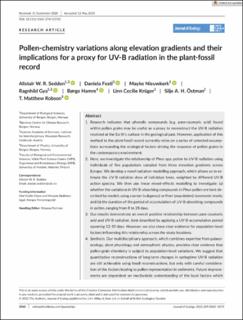| dc.contributor.author | Seddon, Alistair William Robin | |
| dc.contributor.author | Festi, Daniela | |
| dc.contributor.author | Nieuwkerk, Mayke | |
| dc.contributor.author | Gya, Ragnhild | |
| dc.contributor.author | Hamre, Børge | |
| dc.contributor.author | Krüger, Linn Cecilie | |
| dc.contributor.author | Hjortland Östman, Silje Andrea | |
| dc.contributor.author | Robson, T. Matthew | |
| dc.date.accessioned | 2022-04-06T08:36:59Z | |
| dc.date.available | 2022-04-06T08:36:59Z | |
| dc.date.created | 2021-10-19T20:00:07Z | |
| dc.date.issued | 2021 | |
| dc.identifier.issn | 0022-0477 | |
| dc.identifier.uri | https://hdl.handle.net/11250/2990097 | |
| dc.description.abstract | Research indicates that phenolic compounds (e.g. para-coumaric acid) found within pollen grains may be useful as a proxy to reconstruct the UV-B radiation received at the Earth's surface in the geological past. However, application of this method to the plant-fossil record currently relies on a series of untested assumptions surrounding the ecological factors driving the response of pollen grains in the contemporary environment.
Here, we investigate the relationship of Pinus spp. pollen to UV-B radiation using individuals of five populations sampled from three elevation gradients across Europe. We develop a novel radiation-modelling approach, which allows us to estimate the UV-B radiation dose of individual trees, weighted by different UV-B action spectra. We then use linear mixed-effects modelling to investigate: (a) whether the variations in UV-B-absorbing compounds in Pinus pollen are best described by models using coarser (subgenus) or finer (population) taxonomic levels; and (b) the duration of the period of accumulation of UV-B-absorbing compounds in pollen, ranging from 8 to 28 days.
Our results demonstrate an overall positive relationship between para-coumaric acid and UV-B radiation, best described by applying a UV-B-accumulation period spanning 12–19 days. However, we also show clear evidence for population-level factors influencing this relationship across the study locations.
Synthesis. Our multidisciplinary approach, which combines expertise from palaeoecology, plant physiology and atmospheric physics, provides clear evidence that pollen-grain chemistry is subject to population-level variations. We suggest that quantitative reconstructions of long-term changes in springtime UV-B radiation are still achievable using fossil reconstructions, but only with careful consideration of the factors leading to pollen representation in sediments. Future improvements are dependent on mechanistic understanding of the local factors which mediate the UV-B response across different populations, and on upscaling knowledge at the plant level to incorporate longer-term chemical variations represented within sediment samples. | en_US |
| dc.language.iso | eng | en_US |
| dc.publisher | Wiley | en_US |
| dc.rights | Navngivelse-Ikkekommersiell 4.0 Internasjonal | * |
| dc.rights.uri | http://creativecommons.org/licenses/by-nc/4.0/deed.no | * |
| dc.title | Pollen-chemistry variations along elevation gradients and their implications for a proxy for UV-B radiation in the plant-fossil record | en_US |
| dc.type | Journal article | en_US |
| dc.type | Peer reviewed | en_US |
| dc.description.version | publishedVersion | en_US |
| dc.rights.holder | Copyright 2021 The Author(s) | en_US |
| cristin.ispublished | true | |
| cristin.fulltext | original | |
| cristin.qualitycode | 2 | |
| dc.identifier.doi | 10.1111/1365-2745.13720 | |
| dc.identifier.cristin | 1947139 | |
| dc.source.journal | Journal of Ecology | en_US |
| dc.source.pagenumber | 3060-3073 | en_US |
| dc.identifier.citation | Journal of Ecology. 2021, 109 (8), 3060-3073. | en_US |
| dc.source.volume | 109 | en_US |
| dc.source.issue | 8 | en_US |

